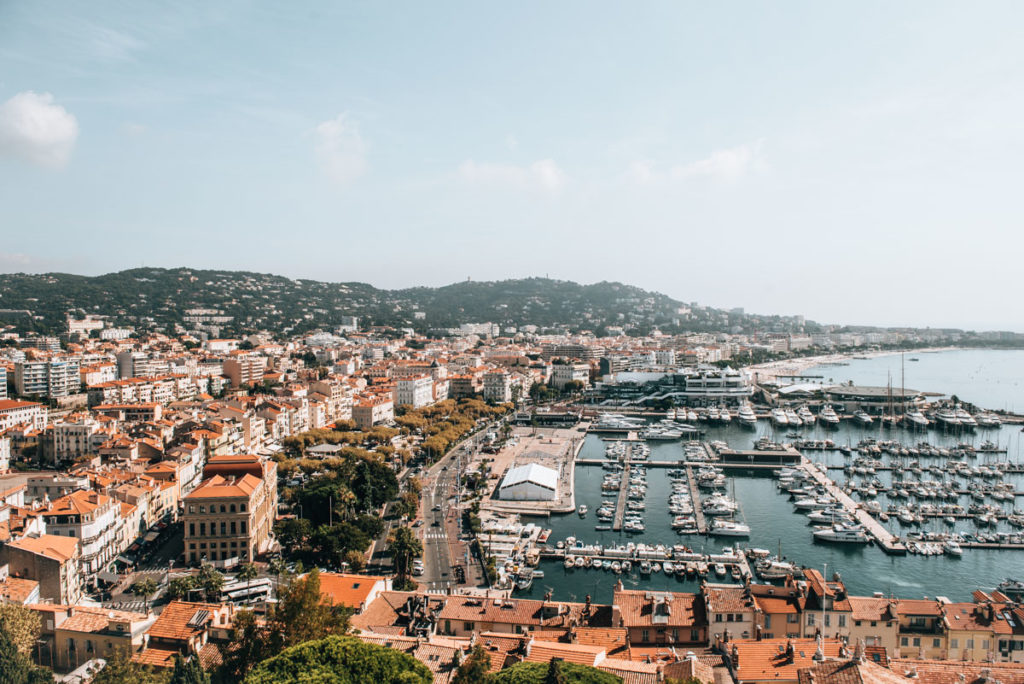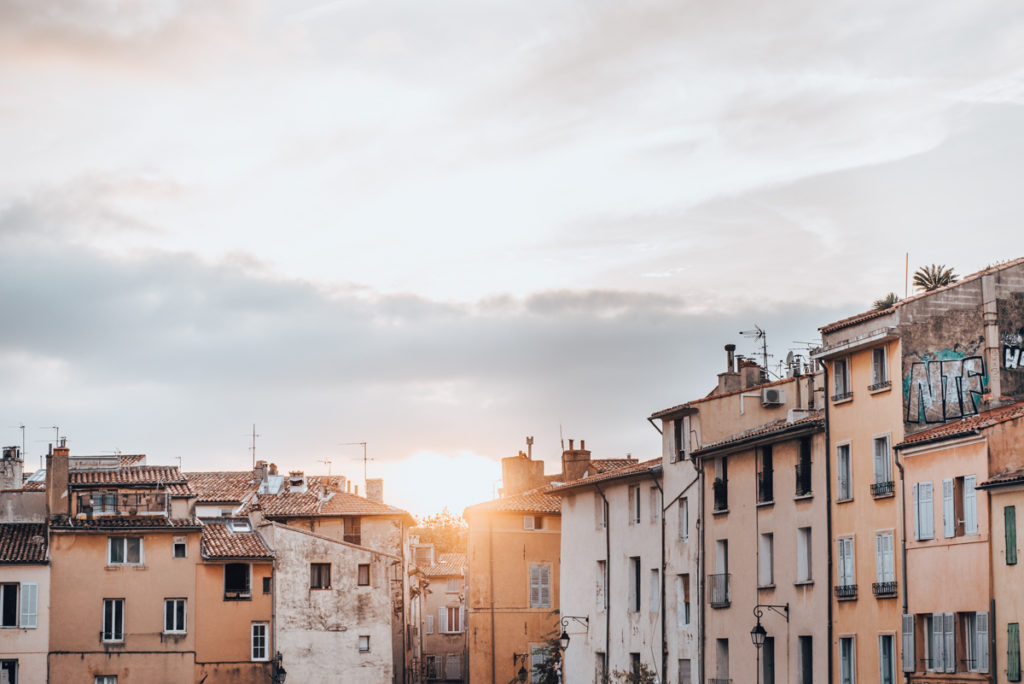Who thinks of curvy coastal roads, the sounds of the sea and the wind crooked palm trees on a road trip through the South of France? What does all this have to do with Lozère? Pretty much nothing! Except for the curvy winding roads… of which there are plenty of in Lozère. The Lozère is wild, barren and untouched. It is the opposite of what you would imagine when you think South of France. It remains in our memories as the most spectacular stop of our journey.
In this blog article we will share with you what it is exactly about the Lozère and its gorges – Gorges du Tarn & Gorges de la Jonte – that had us so enraptured. Of course, as always, we have a few secret tips for you. Are you ready?
Inhalt
- 1. Lozère and the Cévennes National Park: What to expect
- 2. Gorges du Tarn: Villages Along the Tarn Gorge and Things to Do
- 3. Gorges de la Jonte: Villages Along the Jonte Gorge and Things to Do
- 4. Hyelzas: Visit to Fromagerie La Fédou in Sheep-land
- 5. Our Accommodation in Hyelzas: Stay Overnight in the Stone House
- 6. En Route to Florac: Magnificent Views
1. Lozère and the Cévennes National Park: What to expect
Crazy thing: Of all the 96 Départements in mainland France, the Lozère is the least populated one – this is a fact we can confirm as we have rarely travelled through a region as sparsely populated as the Lozère! Often you drive for miles through desolate stretches of land. That’s probably why we liked Lozère so much.
The Lozère is an undeniably spectacular region in the south of France. The two rivers of the Tarn and the Jonte, have dug deep ravines here in the Cévennes and divided them into limestone plateaux: the so-called “Causses”. In other words, the landscape of the Lozère combines breathtaking gorges and endlessly wide barren plateaus. Believe us: this is such a natural spectacle that even several days after the canyon landscapes of the Lozère, we still could not get enough of it. Not to mention the charming, petite mountain villages where time just seems to stands still.
Our experience: Who is Lozère suitable for?
If you are considering a trip to the Lozère, you have to be a nature lover – that’s for sure. The Cévennes National Park is well known for its extensive hiking network: several multi-day hikes run through the Cévennes National Park or through the Lozère. So if you ever wanted to conquer a long-distance hike, then Lozère is the place to go. This region is also very well known for its climbing, with some of the most popular climbing routes in France found along the Tarn Gorge.
But don’t worry: the Lozère is also very easy and very pleasant to explore by rental car, this is what we did. Short hikes are possible in many places.

2. Gorges du Tarn: Villages Along the Tarn Gorge and Things to Do
What follows is a small song of praise to the canyon landscapes of the Lozère: they are so breathtaking that we still lack the words to do this place justice. The start point showcases the spectacular Gorges du Tarn (or the Tarn Gorge), with their mountain villages built on and into the cliff face.
If you drive through the Tarn Gorge valley by car, sometimes it can be a little restrictive. In some places the road is so narrow that we desperately prayed and hoped not to encounter any oncoming traffic. On our left would be the rock wall – and on the right would be the abyss.
You can drive along the entire road from Le Rozier (start point of the Tarn Gorge) to the famous Castelbouc down on the banks of the Tarn. It is definitely worthwhile, to drive up one of these routes at least once, as the Tarn Gorge is most impressive if you admire it from above.
Point Sublime
One of our first encounters here in Lozère was the view from Point Sublime. They couldn’t have given this a more suitable name. Sublime means “overwhelming”, and that is exactly the word that best describes this view point.
From Point Sublime you will find one of the most spectacular sections of the Gorges du Tarn at your feet. The viewpoint is one of the most famous and popular of the entire gorge. The fact that we ended up having a super long photo stop here says it all, no? Our conclusion: definitely worth a stop by!
You can drive with the rental car right up to the lookout point and park there in the free car park. There is also a small café where you can buy something to drink. We also did not take our photos from the official observation deck, but found a quieter spot just a few minutes away.


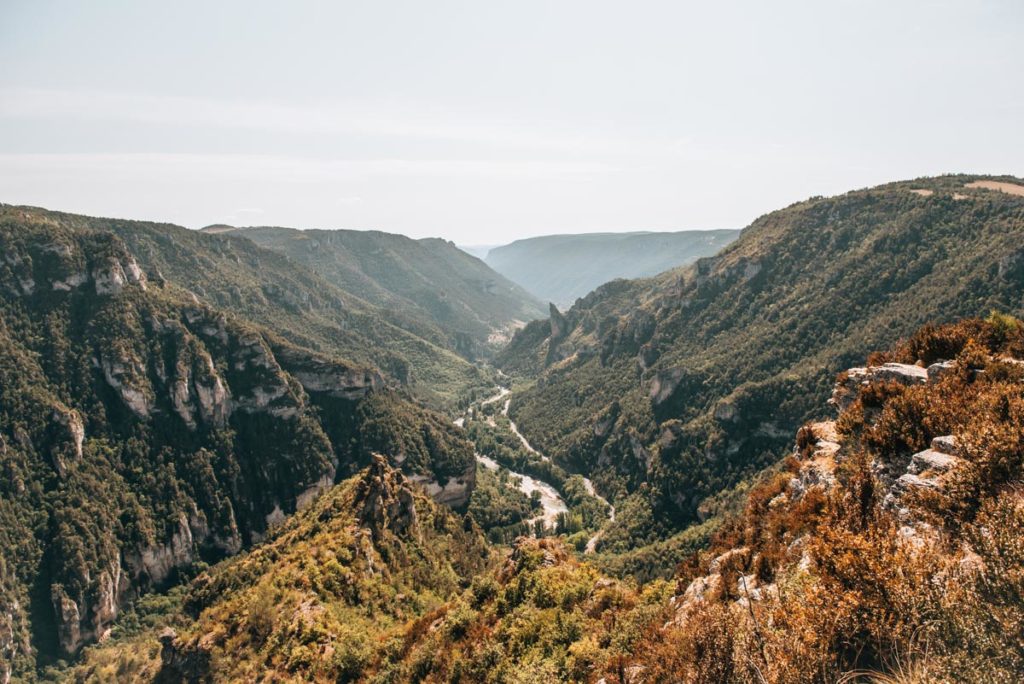
La Malène
La Malène is a story-book village in the Tarn Gorge. The eye-catcher of La Malène is the castle called “Manoir de Montesquoi” and just for this sight alone, is it already worth a stopover. A little tip: in order to capture the entirety of the mountain village and its beauty, you have to see it from afar. If you drive up the hairpin road-bends on the other side of the gorge, you will have a great panoramic view over La Malène.
One more tip: La Malène is also a popular starting point to explore the Tarn Gorge from the water. Unfortunately, we did not do that because of time constraints, but a ride on the “Bateliers des Gorges du Tarn” is said to be quite impressive.


Sainte-Enimie
Sainte-Enimie is the most popular place in the Tarn Gorge. Coming from the west we were presented a magical view of the mountain village and its photogenic bridge upon our arrival. Not surprising that Sainte-Enimie is also considered one of the most beautiful villages in France.
In the centre you will find a comparatively large number of visitors, but don’t worry: Sainte-Enimie still retains the charm of a secluded mountain village. We strongly advise you to park your car and take a walk through the picturesque medieval village centre to the church of Notre-Dame-du-Gourg.





Castelbouc
No village in the Tarn Gorge is as exceptional as Castelbouc. At first glance, one could easily overlook the houses, which press themselves into the rock face itself and look as if they’ve moulded into the surrounding landscape. If you come from Sainte-Enimie, you have a great view of Castelbouc just a few hundred metres from the entrance.
You should park your car no further than at the entrance to the village. There are very few spots, but we got lucky. From the car park you can either take a short walk through Castlebouc or do a 2 hour hike that also passes by the castle ruins.


3. Gorges de la Jonte: Villages Along the Jonte Gorge and Things to Do
A little further south and a little less well-known, but not by any means less worthy of seeing: is the Jonte Gorge – known as “Gorges de la Jonte” in French. She may not be quite as spectacular as her big sister, the Tarn Gorge, but definitely worth a stopover.
Meyrueis
A good start point for exploring the Gorges de la Jonte is Meyrueis. We did not end up seeing as many people in the rest of the Jonte Gorge, as we did in Meyrueis. There are also several cafes, restaurants and hotels. We had a quick “Noisette” (which is the same as an espresso macchiato) in one of the cafes. If you have more time, you can also visit the Grotto of Dargilan, which is about a 15-minute drive from Meyrueis.

Stopover on the way
From Meyrueis you can easily follow the road towards Le Rozier. On the way, there are always worthwhile stopovers, including the lookout point “Belvedere Vautours” for example. It is very close to the Maison des Vautours. FYI: The French “Vautours” translates to “vulture”. In the Maison du Vautours, you can learn more about the vultures that you see in the Jonte Gorge, which fly frequently above you in the sky. However, we were only at the nearby view point, which is a few hundred meters further towards Le Rozier.
Another tip, which was not exactly on the way, but deserves to be mentioned, is the grotto Aven Armand. This stop was not far from our accommodation (more on that later) and apparently is very highly recommended. Unfortunately, we did not have enough time to visit the cave.





Le Rozier
Do not miss the enchanting village of Rozier, where the Tarn and Jonte Gorges meet. Our tip: Le Rozier is simply beautiful to look at from a distance! So park your car just on the side of the road at the entrance towards the centre of the village and enjoy the view. Definitely postcard worthy shot.
And then we also have a second tip that really comes from the heart: In the restaurant “L’Alicanta”, which belongs to the Hôtel Doussière, you not only have a fabulous view, but you can dine very well here. Great recommendation!
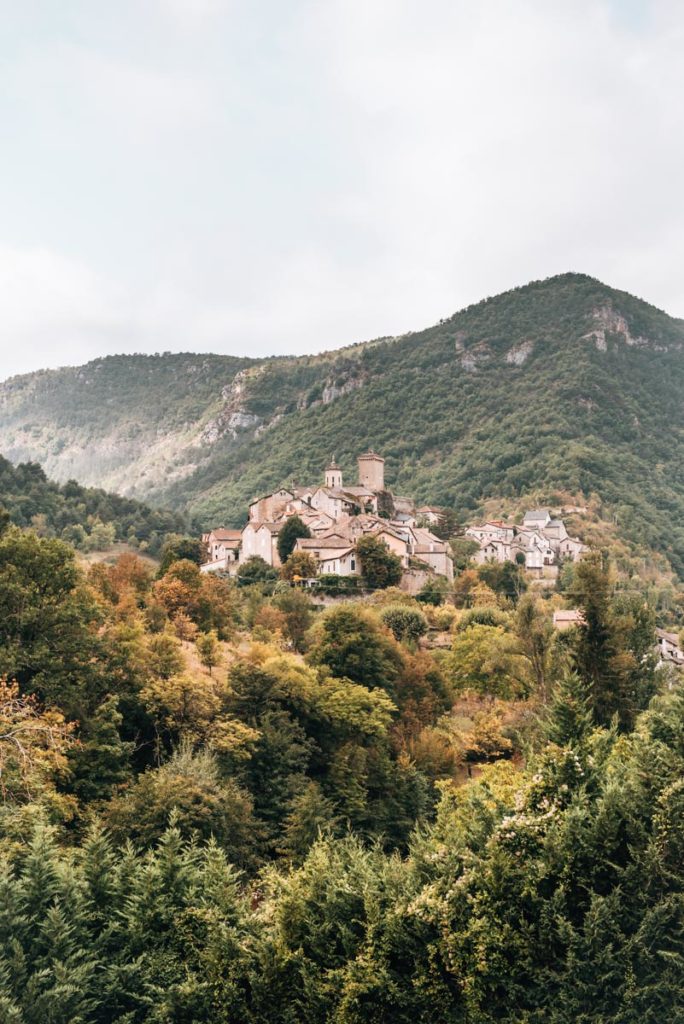




4. Hyelzas: Visit to Fromagerie La Fédou in Sheep-land
From the gorges to the “Causses”, the barren limestone plateaus are also worth a visit in Lozère. It took us to the tiny village of Hyelzas in the Méjan Causeway. And when we say tiny, we mean tiny: Hyelzas has about 50 inhabitants, but ten times as many sheep!
In this idyllic place, you feel like you are miles away from any civilisation. Not only did we stay the night here, but we also paid a visit to the sheep farmer Anaïs. She has created something pretty amazing here: “Des brebis et des hommes”, in English: “By sheep and men”. It gives visitors an authentic and honest insight into sheep farming and cheese production.
Imagine 100% passion! Voilà: This is an afternoon with Anaïs. If anyone from animal-friendly sheep farming understands anything, then it’s them. “I love my sheep,” was the phrase we heard most from her that day. She cuddled, petted and played with the sheep. Their sheep are exclusively used for milk production and are not slaughtered.
After the visit of the sheep, of course, the cheese tasting followed. In the Fromagerie La Fédou, where the milk from Anais’ sheep is turned into cheese. As cheese fans, we declare that rarely have we tasted such good cheese.
Finally, Anaïs took us to a former farm in Hyelzas. If you are in any way historically interested, then we can highly recommend a visit. With the aid of a brochure (which was also available in German) you go on your own from room to room and learn an incredible amount about agriculture in earlier times. Conclusion: Surprisingly exciting!
Important information about “Des brebis et des hommes”
Price: 17 Euros for adults, 14 Euros reduced, 11 Euros for children
Duration: about 3 hours
Language: Anaïs speaks good English; the brochure for the old farm is even in German!
Further information and contact information can be found on the website: Des brebis et des hommes








5. Our Accommodation in Hyelzas: Stay Overnight in the Stone House
In keeping with the charm of the wild Lozère, we stayed for two nights in an old stone house. “Le gîte de La Doline” is the name of the magical place where you feel like you are in the middle of nowhere, a place where we could just switch off and be in the present. Ok, middle of nowhere is an understatement, Hyelzas has at least 50 inhabitants.
The “Le gîte de la Doline” is just as one would imagine accommodation in a 50-inhabitant village and this is exactly what gives it its charm. In the evening, all guests gather to toast the day with an aperitif and then have dinner together – the hostess personally prepares dinner with wine in the decanter.
The “Le gîte de La Doline” only hosts a few rooms. The guests are predominantly hikers because the property is located along a well-known hiking route through the Cévennes National Park. Incidentally, on both days we were not the only ones traveling by car, but also the only non-French guests. The communication was a bit difficult with our broken French, but we still had such wonderful encounters that we didn’t want to miss out!
Another small tip for better orientation: The accommodation is sometimes also called “Gîte Four à pain” (for example, on various signs).
Here is the link to their website, unfortunately it is only in French: Le gîte de La Doline



6. En Route to Florac: Magnificent Views
Expect the unexpected. On our last morning, the Lozère had a little farewell gift in store for us. We were just on the way to the famous Pont du Gard when we were rewarded with this view just before Florac. Words fail you in moments like these, no?
We have marked the Mini View Point, which is right on the road (D 16), on the map so you can find it too. Unfortunately, due to time constraints, we only got a glimpse of Florac as we drove by. But at least we have a reason to come back!

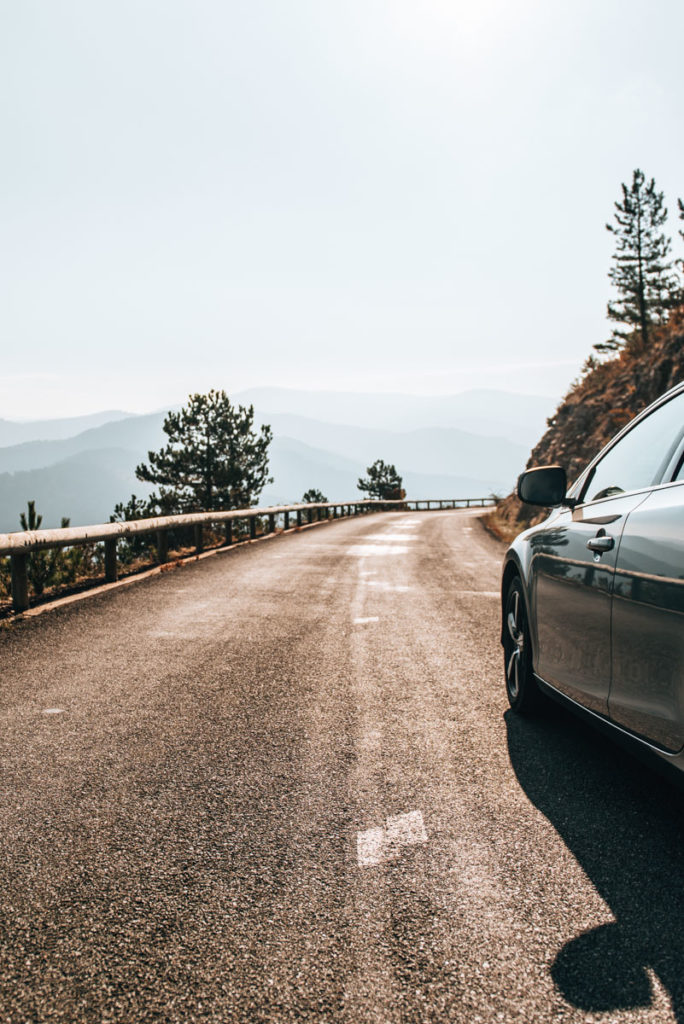
Disclaimer: Advertisement
For this blog article we collaborated with the French National Tourist Board (Atout France). As part of the nature campaign #gesichterfrankreichs we had the privilege to travel for two weeks through the South of France – including the Département Lozère. Of course, this cooperation does not influence our opinion in any way.
This blog article contains our personal recommendations in the form of so-called affiliate links. If you book or buy something through the links, we will receive a small commission. For you, this does not change the price at all. A million thanks from the both of us!
Have you ever been to the Gorges du Tarn, the Gorges de la Jonte or any other place in Lozere? Or do you have any other tips for the region? We look forward to hearing about your experiences and questions in the comments below!

